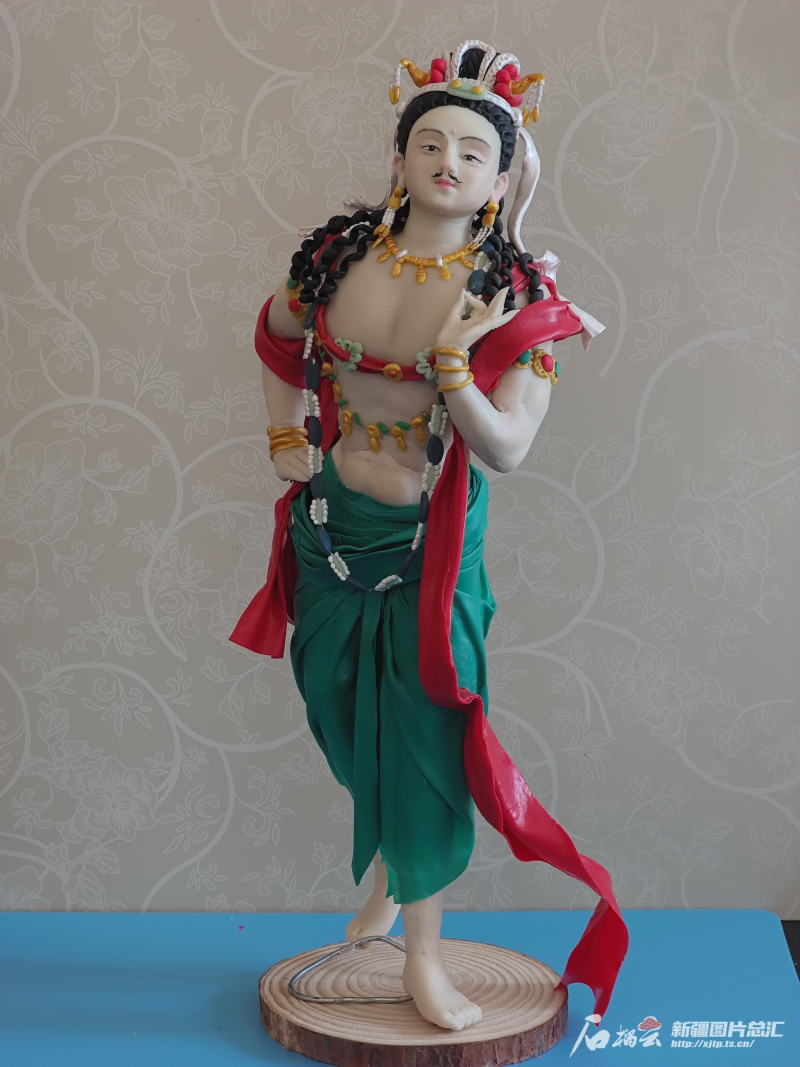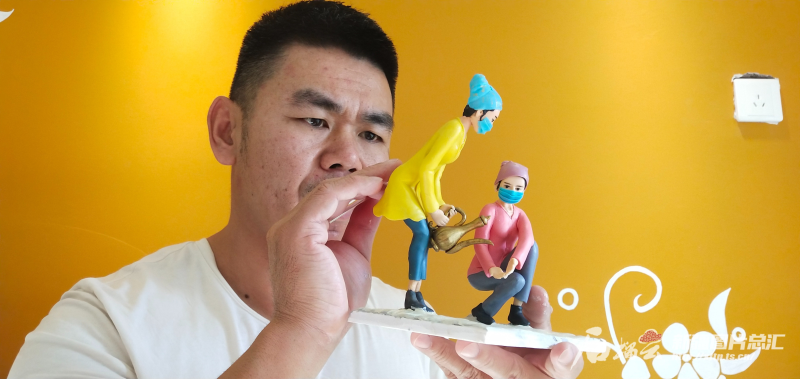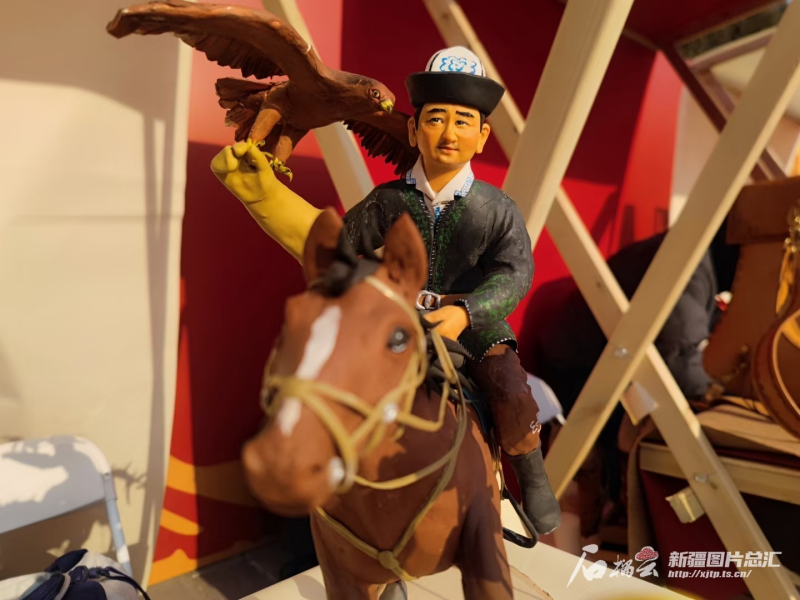Shiliuyun-Xinjiang Daily (Reporter Maygul Ayitgazi) news: On the stage of intangible cultural heritage in Xinjiang, the art of dough figurine making captivates audiences with its unique artistic charm. Huai Yuancheng, a Urumqi municipal-level representative inheritor of the intangible cultural heritage, dough figurine making, uses his skilled hands to transform flour and glutinous rice flour into vivid scenes of Xinjiang's local customs and culture. His work ranges from recreating the murals of the Qiuci Caves to blending traditional craftsmanship with modern techniques, such as incorporating elements of Kazak felt-making techniques. Through the fusion of tradition and modernity, he has been dedicated to the transmission of intangible cultural heritage.

Photo shows lifelike dough figurines by Huai Yuanchen. (Photo provided by Huai Yuanchen)
In 2009, Huai came into contact with the art of dough figurine making by chance. At that time, he was working at an advertising company where he crossed paths with Na Dinghao, a representative inheritor of intangible cultural heritage at the autonomous region level who was engaged in design at the company. The first time he saw those vivid dough figurines in Na's studio, located in the creative industry cluster area on Qifang Street in Urumqi, he was deeply moved and thus began his journey of learning and inheriting the art. "I have loved painting and calligraphy since I was young, but due to limited conditions, I couldn't study them professionally. Dough figurine making allowed me to rediscover my passion for art," said Huai.

Photo shows lifelike dough figurines by Huai Yuanchen. (Photo provided by Huai Yuanchen)
A dough mixed with glutinous rice flour, after being kneaded, shaped, dotted, cut, carved and scratched by his hands, became the distinctive features of the Bodhisattvas in the Qiuci murals, such as their eyebrows and eyes, the wrinkles on their sleeves, and even the ornaments wrapped around their fingertips. What others might see as a tedious "dough play," he has persisted in for over a decade. From an advertising professional to a representative inheritor of intangible cultural heritage, from replicating cave sculptures to cross-border development of cultural and creative products, Huai said, "Dough figurine making is a craft that 'cultivates the mind.' One must use imperfect handmade techniques to preserve the most perfect cultural warmth as much as possible."

Photo shows Huai Yuanchen, a Urumqi municipal-level representative inheritor of the intangible cultural heritage, dough figurine making. (Photo provided by Huai Yuanchen)
When it comes to dough figurine of Xinjiang, Huai believes that there are two major characteristics: first, the themes focus on the local customs and culture of Xinjiang, such as bazaar, camel caravans, and cave art; second, the materials are adapted to local conditions. Due to the dry climate in Xinjiang, the ratio of flour to glutinous rice flour needs to be adjusted to ensure that the dough is flexible and does not crack. "The intangible cultural heritage of dough figurine making can be found all over the country. In the north, the style is simple and rough, while that in the south is delicate and exquisite. However, the dough figurines in Xinjiang pay more attention to telling the stories around them through their works," he explained.
In 2018, when Huai visited the Kizil Caves, he witnessed the damage and loss of the murals due to various factors, which inspired him to recreate the murals of Qiuci Cave using dough figurines. After several months of work, he created a series of dough figurines based on one of the most exquisite representative works of Qiuci murals, the thirteen Bodhisattva murals on the dome of the Kumtura Cave. "The details of this mural are very rich, and every detail needs to be meticulously controlled during creation, from the folds of the clothing to the expressions... By the time a piece is finished, my neck is stiff," Huai said. He stated that dough figurine making is not just an intangible cultural heritage skill but also a means of safeguarding excellent traditional culture.

Photo shows lifelike dough figurines by Huai Yuanchen. (Photo provided by Huai Yuanchen)
To bring traditional craftsmanship to life, Huai attempts to integrate intangible cultural heritage with modern aesthetics. In collaboration with a representative inheritor of Kazakh felt-making techniques, he created a piece that combines a dough figurine camel caravan with a 1.4-meter-long gradient coffee-colored wool felt, presenting the vastness and vitality of the desert. The designed dough figurine works have sold extremely well. Additionally, the windmill-shaped fridge magnets developed for Dabancheng District of Urumqi City, are also very popular. "The cultural warmth of intangible cultural heritage works is the reason why many people, especially young people, love them," said Huai. His company, Urumqi Yuancheng Cultural Development Co., Ltd., focuses on the autonomous region-level intangible cultural heritage of dough figurine making. It emphasizes three main aspects: bringing intangible cultural heritage into schools, the dynamic inheritance of intangible cultural heritage, and artistic creation and cultural innovation development, aiming to integrate traditional crafts into modern life.
In the realm of artistic creation and cultural product development, the company has crafted dough figurines that combine artistic value with practicality. These works encompass categories such as traditional figures, folk scenes, and modern life. The series of cultural products has brought intangible cultural heritage into daily life.
Hua, who has been deeply engaged in dough figurines for over a decade, has always insisted on using craftsmanship to promote the modern expression of traditional skills, and his works have won numerous national and provincial awards. "Intangible cultural heritage is not a frozen historical specimen, but a surging cultural gene," he said.
(A written permission shall be obtained for reprinting, excerpting, copying and mirroring of the contents published on this website. Unauthorized aforementioned act shall be deemed an infringement, of which the actor shall be held accountable under the law.)









